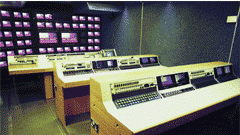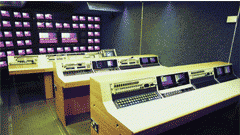UK's Bow Tie Television goes HD

Bow Tie Television was set up in 1990 to supply engineering and operational staff to Broadcast Communications for the second year of experimental live television coverage of the House of Commons chamber. This was a result of having been involved with the first year’s experiment for Limehouse Television in conjunction with Broadcast Communications. In 1991, the contract came up for tender, and in conjunction with CCT Productions, Bow Tie TV won that for a further 5-year period.

One of the key decisions taken at the design stage of Bow Tie Television’s HD truck was to keep the equipment weight over the chassis and not the expanding side. This also helped keep a clear walkway for clients.
By 1993, it was clear that in order to really grow, diversification was required — hence, the move into the OB world. In that year, the first OB truck was acquired, and the company began to expand from there. When the contract with Westminster came up for renewal in 1996, it was decided to concentrate efforts on the OB side of the business, and so the company built its first digital unit. However, when the contract came up for renewal again in 2001, Bow Tie submitted a bid and won.
While that deal provides both a consistent revenue source, as well as the ability to train people and bring them on through to the rest of the company, OB is the main business, bringing in around 75 percent of the annual turnover. The Westminster coverage does give the company a little bit of a production element because it provides full-time television directors, and that gives a slight edge over others in the field.
Bow Tie now has five trucks in total, including the new HD vehicle. The trucks are all digital, beginning with a small Mercedes panel van, and they range in capabilities. The fleet consists of a 4-camera vehicle with four video tape machines (VTs); two coach-bodied, 6-camera vehicles with four VTs; a 12-camera, 8-VT vehicle; and the recently completed arctic trailer with 20 cameras and 12 VTs.
Taking the HD plunge
Bow Tie’s decision to take the HD plunge was due to several factors. About 16 months ago, it became apparent that the company had topped out in terms of its ability to offer clients exactly what they required. Technically, there wasn’t a problem; however, it had become difficult to accommodate all the people required to operate the equipment for certain coverage. While equipment had decreased in size, allowing more pieces to fit into a small truck, making room for the requisite number of equipment operators had increasingly become an issue.
Get the TV Tech Newsletter
The professional video industry's #1 source for news, trends and product and tech information. Sign up below.
The sound studio uses the Calrec Sigma 100 and Genelec monitors.
The obvious solution was a bigger truck. The company didn’t want to be perceived as the last one in the UK to build an SDI-only expanded articulated trailer. It just wasn’t an economically viable option. The logical extension to that thinking was to move the company into the HD world.
At the time that the decision was made, there weren’t any HD OB trucks in the UK. The HD market was being covered by AlfaCam from Belgium. While it was clear that one truck was under construction, it made sense to move into the market early. Bow Tie now has the second HD truck in the UK.
Although HD broadcasting here is a long way off, demands from the production community drive the company, and some people want the best and need to consider other formats and factors. HD is continuing to grow in Japan, via NHK, and the market is beginning to develop in the USA. Not only that, but with the new Blu-ray DVDs on the way — with their ability to hold vast amounts of information — and with consumers likely to begin looking at both plasma and LCD screens when they next purchase a TV set, both of which can be HD-compatible, there is clear potential there.
Bow Tie selected two Eclipse routers from Chyron’s Pro-Bel range along with a Freeway 64 AES router and an Aurora system controller.
Taking a long and hard look at the production market, there were clearly opportunities. It was interesting to note that some recent pop concerts were not using HD OB units, but rather they were using HD camcorders linked together. Having too many HD camcorders linked together becomes an editor’s nightmare. Some high-end production companies had begun to fully embrace HD, but there is still resistance in the market.
And it is clear that there are those that still believe that you can’t cut an HD show as you can SD. That is not now the case. The technology is the same except for the cameras, vision mixer and routers. There are also so many HD formats out there, making it highly confusing. The belief is that these will shake down, but quite when or how is not yet clear.
Design considerations
With all the design and build decisions, there was one key factor that had to be kept in mind and at all times: flexibility. The decision was made to keep the footprint of the trailer as small as possible for precisely that reason. The rationale behind this is simple. With a truck that’s too big, there are times when it is impossible to position it into the designated area to provide coverage. The truck is just short of 14 meters, but it has only been expanded by 1.2 meters in width. The overall width is 3.5 meters, and the stairs are parallel to the body. The next core criterion was to provide the client with as much space as possible in which to operate. After looking at the production layout, the company was wary about putting any weight over the expanding side. It was decided to design the truck so that the equipment is placed across it. This also maximizes the space for clients. All the weight is within the chassis; the only weight on the expanding side is the expanding side itself. Clients have easy and clear access to all the necessary equipment.
Bow Tie’s new HD truck is equipped with Sony Grade 1 monitors.
In regard to system design and integration, one of the most complex factors involved in the initial phases of this vehicle was the wiring. For this, an external supplier was used, but all the systems integration was carried out internally. The company has the expertise to do so, given the engineering background of key employees. Equipment was purchased on a manufacturer-by-manufacturer basis.
Essentially, the truck is designed around an SD platform — so it is obviously fully SD-capable — and then the company placed an HD layer over the top. Core to the ability to provide this is the Chyron/Pro-Bel routing and control equipment that the company purchased and installed. Bow Tie acquired two Eclipse routers.
One is an SDI 128x256, and the second is HD 32x32. It also purchased a fully equipped Freeway 64 AES router. In order to control these, the company is using Chyron’s Aurora system controller, together with a wide range of panels. This provides an integrated control architecture.
At the heart of the system is a 3RU frame housing the main controller. In the broadcast world, price isn’t always the key issue; specifications and power of equipment are important. Listening to the market and demands from clients is also part of the decision-making process because there is no point in installing equipment that is unfamiliar to those who are likely to be using it. It is important to work with companies that have built up years of experience.
Again, flexibility is key. The system can provide simultaneous HD and SD because the company believes that there is a market for that. Some clients may well want to master in HD while broadcasting in SD.
It was necessary to also have the option for a router to be SD one day and HD the next. The software can be easily reconfigured. The company opted for a large SD router so that switching everything around is not difficult. For example, on one of the first SD jobs that the truck was used for, the engineers were pleased to discover that they only had to use six patch cords. The company purchased 10 Thomson LDK 6000 WorldCams , which are also multi-format. Thomson SD and HD vision mixers were selected, along with a Telex talkback system and Sony Grade 1 HD monitors. JVC preview monitors have been installed. The TSL UMD system was chosen, and for the audio desk, the new Calrec Sigma 100 has been fitted.
Other considerations
Involved in all these purchasing decisions are considerations of space, power consumption, heat generation, control interfaces and integration with other technology that the company has selected. Bow Tie looked at reliability and whether it has had experience with the technology, or technology from that manufacturer, before.
Integration with this project has not been a problem. There are always small glitches, but no major hurdles have had to be overcome. There is always the odd piece of equipment that is supplied with different connectors to the ones specified, but the installation has gone more or less as expected.
The second most time-consuming factor with this OB truck was setting up all of the software. Virtually every item has PC-based software driving it or providing the front end. It takes time to ensure that it is all functioning as it should. One of the key situations to avoid is overloading PCs. Therefore, three, sometimes four, PCs are used to provide the desired stability.
The company decided to use the truck first for several small SD jobs so that it had a chance to make sure the equipment was running smooth-ly before tackling larger projects. The truck has proven to be successful. So far, the installation has worked exactly as planned, and Bow Tie Televison is satisfied with the technology choices.
John Knopp is the managing director of Bow Tie Television.
Design TeamDafydd Rees, Bow Tie chief engineerJohn Knopp, Bow Tie managing directorEquipment listEyeheight ARCGenelec audio monitoringThomson LDK-6000 camerasCTP Systems, RTS/Telex commsJVC general monitorsVistek, AJA and Avitel glueBryant Broadcast hardware/cablesEvertz HD TSGThomson HD vision mixerMarshall LCD monitorsZandar DX-4 quad splitsChyron/Pro-Bel routersThomson XtenDD SD vision mixerCalrec Sigma sound mixerTrilogy SPG, SD TSG, changeoverLeitch/DPS synchronizersTektronix SD and HD waveform monitorsTSL UMD, tally control
